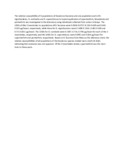| dc.description.abstract | The relative susceptibility of 4 populations of Dysdercus fasciatus and one population each of D. nigrofasciatus, D. cardinalis and D. superstitiosus to topical application of cypermethrin, fenvalerate and permethrin was investigated in the laboratory using individuals collected from cotton in Kenya. The LD50s of the 3 insecticides to populations of D. fasciatus were 0.0656-0.0757, 0.335-0.469 and 0.442-0.505 µg/insect, respectively, while those for D. nigrofasciatus were 0.1690-0.2541, 0.481-0.504 and 0.721-0.851 µg/insect. The LD50s for D. cardinalis were 0.1507, 0.714, 0.798 µg/insect for each of the 3 insecticides, respectively, and the LD50s for D. superstitiosus were 0.0991 and 0.824 µg/insect for cypermethrin and permethrin, respectively. Based on D. fasciatus from Kibos as the reference strain, the relative susceptibilities of all populations of the Dysdercus species studied were small (<4-fold), indicating that resistance was not apparent. Of the 3 insecticides tested, cypermethrin was the most toxic to these pests. | en_US |

